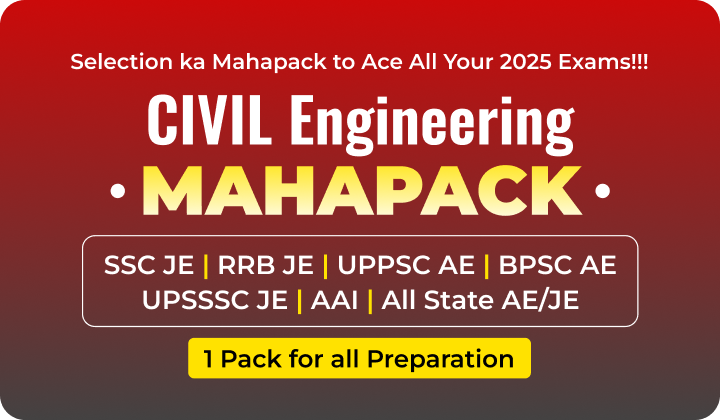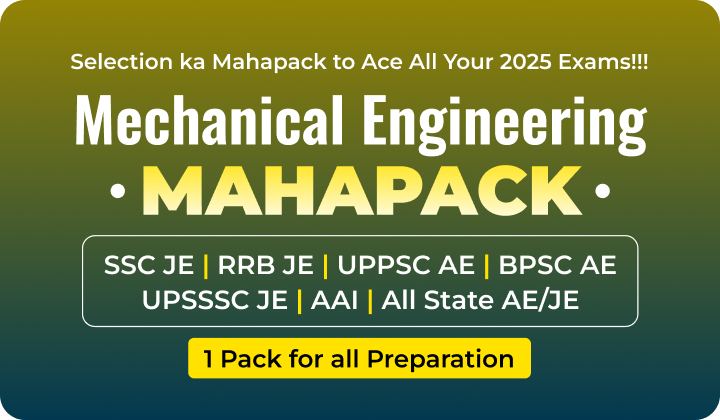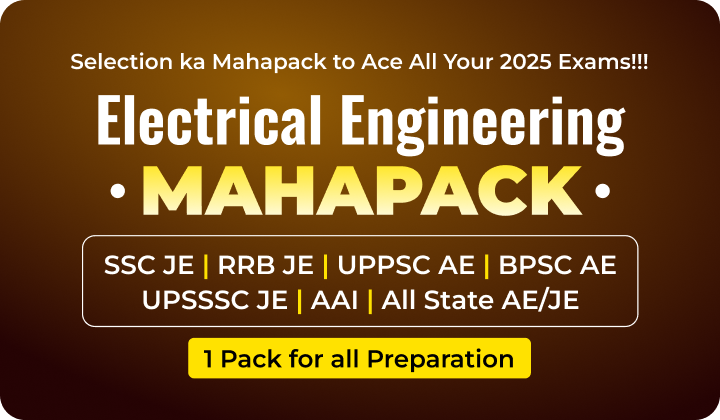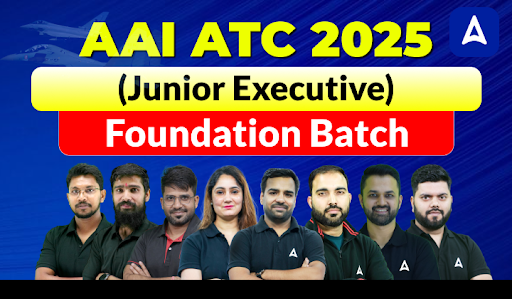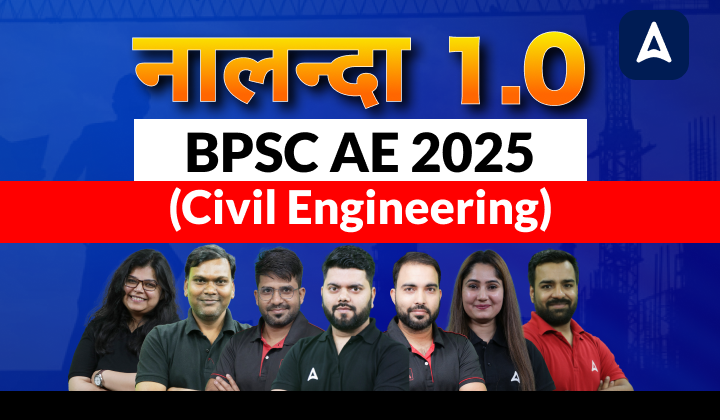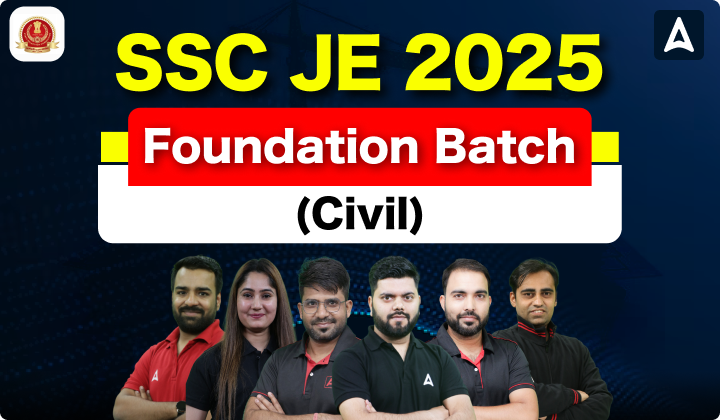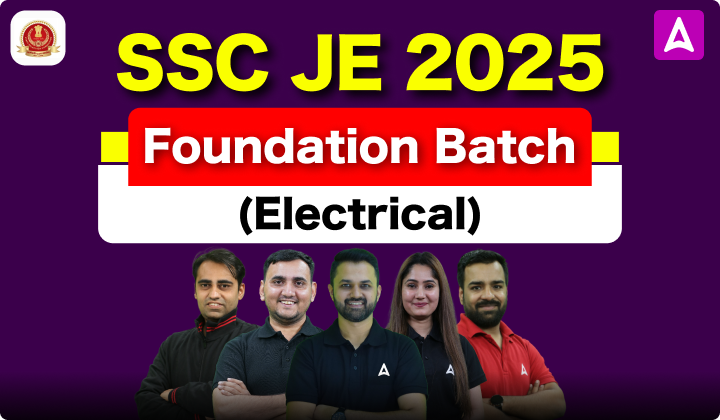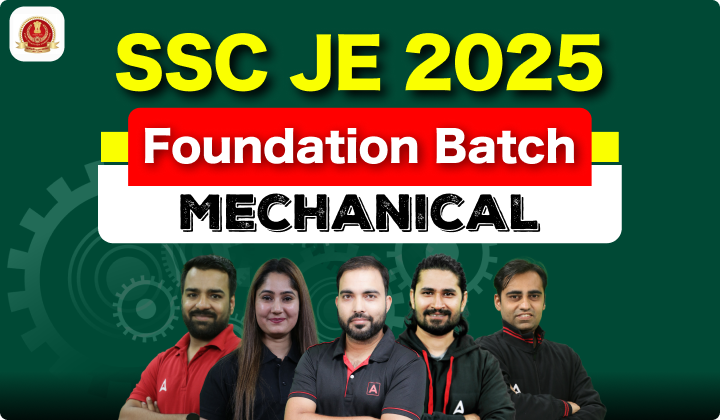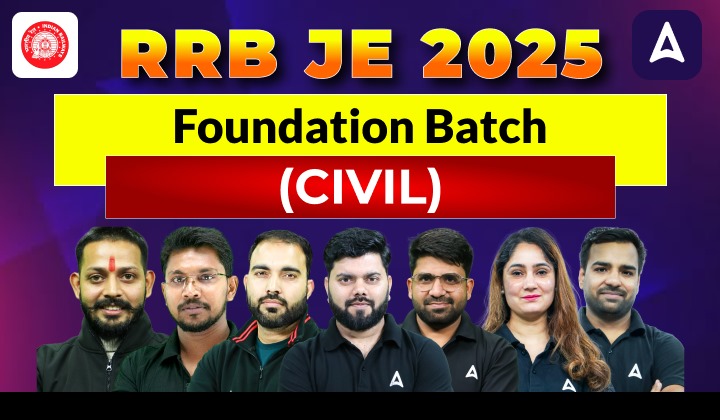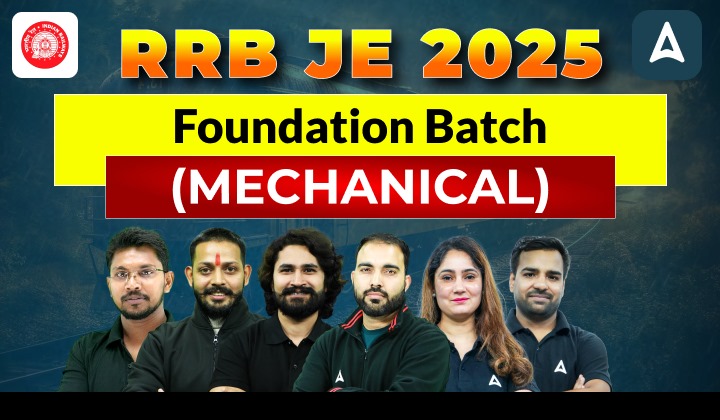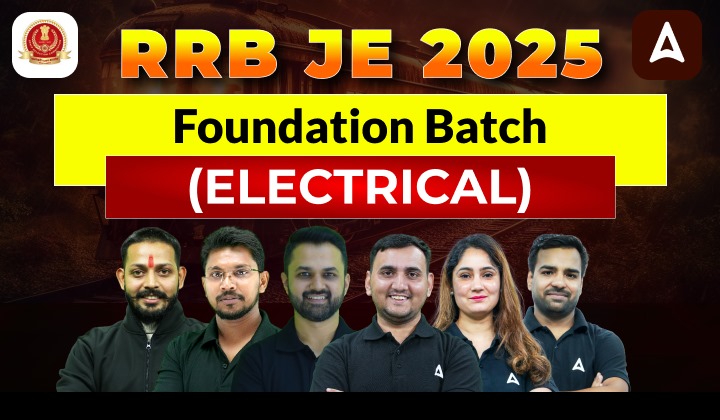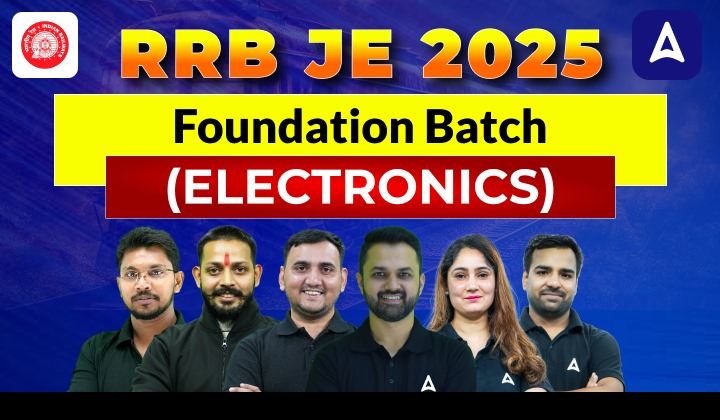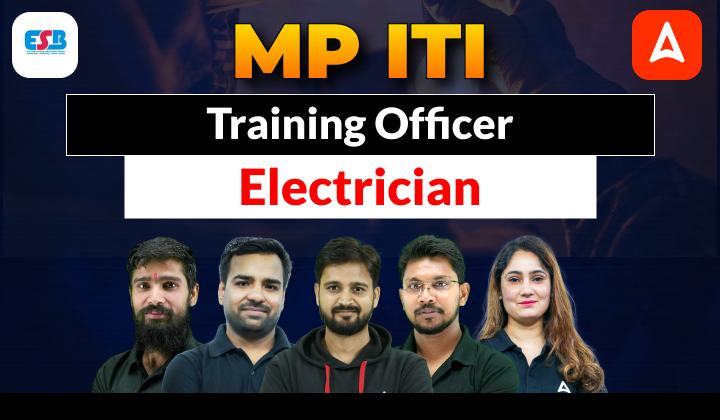Table of Contents
RRB JE Syllabus and Exam Pattern
Candidates preparing for the RRB JE 2025 Exam should know important details about the exam syllabus. Here’s a simple overview of the RRB JE Syllabus and Exam Pattern to help you get ready:
| RRB JE Syllabus 2025 |
|
| Conducting Body | Railway Recruitment Board (RRB) |
| Name of the Examination | RRB Junior Engineer Exam |
| Name of the Posts | Junior Engineer (JE), Junior Engineer (IT), Depot Materials Superintendent (DMS), Chemical & Metallurgical Assistant (CMA) |
| Number of Vacancies | 7951 |
| Exam Type Level | All India Level |
| Number of Questions | CBT-1- 100
CBT-2-150 |
| Marking Scheme | 1 Mark |
| Negative Marking | 1/3 Mark |
| RRB JE CBT 2 Exam Date | 22 April 2025 |
| RRB JE Official Website | indianrailways.gov.in |
RRB JE Exam Pattern 2025
RRB JE CBT 2 Exam Pattern 2025
Here is the RRB JE CBT 2 Exam Pattern for 2025:
- A total of 150 Multiple-choice questions (MCQs) will be asked in the CBT 2 Exam, each carrying 1 mark.
- The subjects covered in RRB JE CBT 2 include General Awareness, Physics & Chemistry, and Basics of
- Computers and Applications, Basics of Environment and Pollution Control, and Technical Abilities.
- Minimum Qualifying Marks: 40%
- The exam duration is 2 hours (120 minutes).
- For each incorrect answer, there will be a negative marking of 1/3rd mark.
| RRB JE CBT 2 Exam Pattern | |||
| Exam Name | Subjects | Marks | Time Duration |
| RRB CBT-2 | General Awareness | 15 | 120 Minutes |
| Physics & Chemistry | 15 | ||
| Basics of Computer Applications | 10 | ||
| Basics of Environmental & Pollution | 10 | ||
| Technical Discipline | 100 | ||
| Total | 150 Marks | ||
RRB JE CBT 1 Exam Pattern 2025
Here is the RRB JE CBT 1 Exam Pattern for 2025:
- The CBT 1 Exam will consist of 100 Multiple-choice questions (MCQs), each carrying 1 mark.
- The subjects covered in RRB JE CBT 1 include Mathematics, General Awareness & Reasoning, and General
- Awareness and General Science.
- Minimum Qualifying Marks: 40%
- The duration of the exam is 1.5 hours (90 minutes).
- There will be a negative marking of 1/3rd mark for each incorrect answer.
| RRB JE CBT 1 Exam Pattern | |||
| Exam Name | Subjects | Marks | Total Duration |
| RRB CBT-1 | Mathematics | 30 | 90 Minutes |
| General Awareness | 15 | ||
| General Science | 30 | ||
| General Intelligence & Reasoning | 25 | ||
| Total | 100 Marks | ||
RRB Junior Engineer Syllabus 2025
In the following section, we present a thorough breakdown of the RRB Junior Engineer Syllabus 2025, aimed at aiding candidates in their extensive preparation for the RRB JE Recruitment 2025 Exam. Understanding the RRB JE exam pattern and the subjects covered is just the starting point; it’s equally important to thoroughly explore each topic within the syllabus. Understanding the RRB JE Syllabus 2025 is crucial, as it acts as an important guide to achieving success in the RRB JE CBT 1 & CBT 2 2025 Exam.
RRB JE CBT 2 Syllabus
General Awareness Topics for CBT 2 Syllabus
In this section, we have discussed the General Awareness Topics in detail. Candidates who are preparing for the RRB JE Exam must keep checking the detailed RRB JE 2025 Syllabus here:
- Knowledge of Current affairs
- Indian Geography
- Culture and history of India, including the freedom struggle
- Indian Polity and Constitution
- Indian Economy
- Environmental Issues Concerning India and the World
- Sports
- General scientific and technological developments, etc.
Physics and Chemistry Topics for CBT 2 Syllabus
In this section, we have discussed the Physics and Chemistry Topics in detail. Candidates who are preparing for the RRB JE Exam must keep checking the detailed RRB JE 2025 Syllabus here:
- Questions on 12th standard Physics and Chemistry.
Basics of Computers and Applications: Topics for CBT 2 Syllabus
In this section, we have discussed the Basics of Computers and Applications Topics in detail. Candidates who are preparing for the RRB JE Exam must keep checking the detailed RRB JE 2025 Syllabus here:
- Computers and their architecture
- Input & Output devices
- MS Office
- Storage devices
- Operating Systems
- Internet and Email
- Websites & Web Browsers
- Networking
- Computer Virus
Basics of Environment and Pollution Control Topics for CBT 2 Syllabus
In this section, we have discussed the Basics of environmental and Pollution Control Topics in detail. Candidates who are preparing for the RRB JE Exam must keep checking the detailed RRB JE 2025 Syllabus here:
- Basics of Environment
- The adverse effects of environmental pollution
- Pollution control strategies
- Types of pollution
- Waste Management
- Global warming
- Acid rain
- Ozone depletion
RRB JE Technical Syllabus 2025
In this section, we have discussed the RRB JE Technical Syllabus 2025 in detail for various branches of engineering. Candidates who are preparing for the RRB JE Exam must keep checking the detailed RRB JE Syllabus branch-wise here:
RRB JE Civil Syllabus 2025
The RRB JE Civil Engineering Syllabus 2025 is summarized in the tabular form below for the proper understanding of the candidates:
| Subject | Topics |
|---|---|
| Engineering Mechanics | – Force (resolution of force, moment of force, force system, composition of forces), Equilibrium, Friction, Centroid and Center of gravity, Simple machines. |
| Building Construction | – Building components (substructure, superstructure), type of structure (load bearing, framed and composite structures). |
| Building materials | – Masonry materials (stones, bricks, and mortars), Timber, and miscellaneous materials (glass, plastic, fiber, aluminum steel, galvanized iron, bitumen, PVC, CPVC, and PPF). |
| Construction of substructure | – Job layout, earthwork, foundation (types, dewatering, coffer dams, bearing capacity). |
| Construction of superstructure | – Stone masonry, brick masonry, Hollow concrete block masonry, composite masonry, cavity wall, doors and windows, vertical communication (stairs, lifts, escalators), scaffolding, and shoring. |
| Building finishes | – Floors (finishes, process of laying), walls (plastering, pointing, painting), and roofs (roofing materials including RCC). |
| Building maintenance | – Cracks (causes, type, repairs- grouting, uniting, epoxy, etc.), settlement (causes and remedial measures), and re-baring techniques. |
| Building Drawing | – Conventions (type of lines, symbols), planning of building (principles of planning for residential and public buildings, rules and byelaws), drawings (plan, elevation, section, site plan, location plan, foundation plan, working drawing), perspective drawing. |
| Concrete Technology | – Properties of various types/grades of cement, properties of coarse and fine aggregates, properties of concrete (water-cement ratio, properties of fresh and hardened concrete), Concrete mix design, testing of concrete, quality control of concrete (batching, formwork, transportation, placing, compaction, curing, waterproofing), extreme weather concreting and chemical admixtures, properties of special concrete (ready mix, RCC, pre-stressed, fiber reinforced, precast, high performance). |
| Surveying | – Types of survey, chain and cross staff survey (principle, ranging, triangulation, chaining, errors, finding area), compass survey (principle, bearing of line, prismatic compass, traversing, local attraction, calculation of bearings, angles and local attraction) leveling (dumpy level, recording in level book, temporary adjustment, methods of reduction of levels, classification of leveling, tilting level, auto level, sources of errors, precautions and difficulties in leveling), contouring (contour interval, characteristics, method of locating, interpolation, establishing grade contours, uses of contour maps), area and volume measurements, plane table survey (principles, setting, method), theodolite survey (components, adjustments, measurements, traversing), Tacheometric survey, curves (types, setting out), advanced survey equipment, aerial survey and remote sensing. |
| Computer-Aided Design | – CAD Software (AutoCAD, Auto Civil, 3D Max, etc.), CAD commands, generation of the plan, elevation, section, site plan, area statement, and 3D view. |
| Geo Technical Engineering | – Application of Geo-Technical Engineering in the design of foundations, pavement, earth retaining structures, earthen dams, etc., physical properties of soil, permeability of soil and seepage analysis, shear strength of soil, bearing capacity of soil, compaction and stabilization of soil, site investigation and subsoil exploration. |
| Hydraulics | – Properties of fluid, hydrostatic pressure, measurement of liquid pressure in pipes, fundamentals of fluid flow, flow of liquid through pipes, flow through open channel, flow measuring devices, hydraulic machines. |
| Irrigation Engineering | – Hydrology, investigation and reservoir planning, percolation tanks, diversion headworks. |
| Mechanics of Structures | – Stress and strain, shear force and bending moment, moment of inertia, stresses in beams, analysis of trusses, strain energy. |
| Theory of structures | – Direct and bending stresses, slope and deflection, fixed beam, continuous beam, moment distribution method, columns. |
| Design of Concrete Structures | – Working Stress method, Limit State method, analysis and design of singly reinforced and doubly reinforced sections, shear, bond and development length, analysis and design of T Beam, slab, axially loaded column and footings. |
| Design of Steel Structures | – Types of sections, grades of steel, strength characteristics, IS Code, Connections, Design of tension and compression members, steel roof truss, beams, column bases. |
| Transportation Engineering | – Railway Engineering (alignment and gauges, permanent way, railway track geometrics, branching of tracks, stations and yards, track maintenance), Bridge engineering (site selection, investigation, parts of bridge, permanent and temporary bridges, inspection and maintenance), Tunnel engineering (classification, shape and sizes, tunnel investigation and surveying, method of tunneling in various strata, precautions, equipment, explosives, lining and ventilation). |
| Highway Engineering | – Road Engineering, investigation for road projects, geometric design of highways, construction of road pavements and materials, traffic engineering, hill roads, drainage of roads, maintenance and repair of roads. |
| Environmental Engineering | – Environmental pollution and control, public water supply, domestic sewage, solid waste management, environmental sanitation, and plumbing. |
| Advanced Construction Techniques and Equipment | – Fibers and plastics, artificial timber, advanced concreting methods (underwater concreting, ready mix concrete, trimix concreting, special concretes), formwork, pre-fabricated construction, soil reinforcing techniques, hoisting and conveying equipment, earth moving machinery (excavation and compaction equipment), concrete mixers, stone crushers, pile driving equipment, working of hot mix bitumen plant, bitumen paver, floor polishing machines. |
| Estimating and Costing | – Types of estimates (approximate, detailed), mode of measurements, and rate analysis. |
| Contracts and Accounts | – Types of engineering contracts, Tender and tender documents, payment, and specifications. |
RRB JE Electrical Syllabus 2025
Below is a table summarizing the syllabus for Electrical & Allied Engineering:
| Topic | Subtopics |
|---|---|
| Basic concepts | Resistance, inductance, capacitance, current, voltage, power, energy, and their units. |
| Circuit law | Kirchhoff’s laws, network theorems for simple circuit solutions. |
| Magnetic Circuit | Flux, mmf, reluctance, magnetic materials, magnetic calculations for different conductors, electromagnetic induction, self, and mutual induction. |
| AC Fundamentals | Alternating wave values (Instantaneous, peak, R.M.S., average), sinusoidal waveform, series and parallel AC circuits, resonance, tank circuit, Poly Phase system, star and delta connection, 3-phase power, DC and sinusoidal response of R-L and R-C circuits. |
| Measurement and measuring instruments | Measurement of power and energy, wattmeter methods, frequency and phase angle measurement, ammeter, voltmeter, multimeters, Megger, AC bridges, CRO, signal generator, CT, PT, earth fault detection. |
| Electrical Machines | (a) D.C. machines – construction, principles, characteristics, speed control, braking, efficiency. (b) Transformers – construction, operation, equivalent circuit, voltage regulation, tests, efficiency, parallel operation, autotransformers. (c) 3-phase induction motors – operation, equivalent circuit, torque-speed characteristics, speed control, braking, fractional kW motors, single-phase induction motors. |
| Synchronous Machines | 3-phase e.m.f generation, armature reaction, voltage regulation, parallel operation of alternators, synchronizing, active and reactive power control, applications of synchronous motors. |
| Generation, Transmission, and Distribution | Power stations, load factor, tariffs, faults, switchgear, protection, Buchholz relay, Merz-Price system, lightning arresters, transmission and distribution systems, cables. |
| Estimation and Costing | Lighting scheme estimation, electric installation, IE rules, earthing practices. |
| Utilization of Electrical Energy | Illumination, electric heating, welding, electroplating, electric drives and motors. |
| Basic Electronics | Electronic devices (diodes, transistors, BJTs, JFETs), simple circuits using these devices. |
RRB JE Electronics Telecommunication Engineering Syllabus 2025
The RRB JE Electronics and Telecommunication Engineering Syllabus 2025 is given below in the table:
Here’s a table summarizing the syllabus for Electronics & Allied Engineering:
| Topic | Subtopics |
|---|---|
| Electronic Components & Materials | Conductors, semiconductors, insulators, magnetic materials, jointing & cleaning materials, cells and batteries, relays, switches, MCBs, and connectors. |
| Electronic Devices and Circuits | PN Junction diodes, thyristor, diode and triode circuits, junction transistors, amplifiers, oscillators, multivibrators, counters, rectifiers, inverters, UPS. |
| Digital Electronics | Number System & Binary codes, Boolean Algebra & Logic gates, combinational & sequential logic circuits, A/D & D/A converters, counters, and memories. |
| Linear Integrated Circuit | Introduction to operational amplifiers, linear and nonlinear applications, voltage regulators, timers, and phase-locked loops. |
| Microprocessor and Microcontroller | Introduction to microprocessors, 8085 microprocessor working, assembly language programming, peripherals, microcontrollers. |
| Electronic Measurements | Measuring systems, basic principles of measurement, range extension methods, cathode ray oscilloscope, LCD, LED panel, transducers. |
| Communication Engineering | Introduction to communication, modulation techniques, multiplexing techniques, wave propagation, transmission line characteristics, OFC, fundamentals of public address systems, electronic exchange, radar, cellular and satellite communication. |
| Data Communication and Network | Introduction to data communication, hardware and interface, introduction to networks and networking devices, local area network and wide area network, interworking. |
| Computer Programming | Programming concepts, fundamentals of ‘C’ and C++, operators in ‘C’ and C++, control statements, functions, arrays, strings, pointers, file structure, data structure, and DBMS. |
| Basic Electrical Engineering | DC circuits, AC fundamentals, magnetic, thermal, and chemical effects of electric current, earthing – installation, maintenance, testing. |
RRB JE ME Syllabus 2025
Here’s a table summarizing the syllabus for Mechanical & Allied Engineering:
| Topic | Subtopics |
|---|---|
| Engineering Mechanics | Resolution of forces, Equilibrium, parallelogram law, triangle law of forces, polygon law of forces, Lami’s theorem, couple and moment, static friction, dynamic friction, limiting angle of friction and repose, forces on inclined plane, moment of inertia and radius of gyration of various sections, Newton’s laws of motion, projectile motion, D’Alembert’s principle, conservation of energy and momentum |
| Material Science | Mechanical properties of materials (tensile strength, hardness, etc.), classification of steels, heat treatment processes (annealing, hardening, etc.) |
| Strength of Materials | Stress, strain, stress-strain diagram, factor of safety, thermal stresses, strain energy, shear force and bending moment diagrams, torsion, thin cylinder shells |
| Machining | Lathe working principle, types of lathes, cutting tool nomenclature, machining operations, cutting fluids, introduction to shaper, slotter, planer, broaching, milling, gear manufacture, heat treatment of gears |
| Welding | Welding introduction, classification, principles of arc and gas welding, soldering and brazing, modern welding methods, MIG & TIG welding |
| Grinding & Finishing Process | Metal removal principles, abrasives, grinding machines, centreless grinding, finishing processes (honing, lapping, etc.), electroplating, |
| Metrology | Linear measurement, angle measurement, bevel protractor, sine bar, angle slip gauges, measurement of surface roughness, methods of measurement by comparison, tracer instruments and by interferometry, collimators, measuring microscope, interferometer, inspection of machine parts using the concepts of shadow projection and profile projection. |
| Fluid Mechanics & Hydraulic Machinery | Properties of fluid (density, specific weight, specific gravity, surface tension, viscosity, compressibility), Pascal’s law, measurement of pressures, the concept of buoyancy, the concept of Reynolds number, pressure, potential and kinetic energy, total energy, laws of conservation, mass, energy, and momentum, the velocity of liquids and discharge, Bernoulli’s equation and assumption, venturi meters, pitot tube, current meters, centrifugal pumps, efficiencies, working principle of jet & submersible pumps with line diagrams. |
RRB JE CSE Syllabus 2025
The RRB JE CSE Syllabus 2025 is given below in the table:
| Subject | Topics |
|---|---|
| PC Software | – MS Windows, MS Word, MS Excel & PowerPoint |
| Computer fundamentals | – Evolution of Computers, Hardware & Software, Internet. |
| C Language | – Structure, Loop, Control Statements, Arrays, Pointers, Functions, Structure and Union, Files |
| Computer Organisation | – Number Systems, Logic Gates, Flip-Flops, Boolean Algebra, DMA, Instruction Sets. |
| Information Systems | – Information concepts, Hardware & Software, Overview of Communication Systems, E-Commerce |
| Data Structure using C++ | – Object-oriented Programming, Data Structures, Stack, Queue, Pointers, Linked List, Searching & Sorting Algorithms |
| DBMS fundamentals | – BASIC, Data Models, RDBMS, Relational Algebra, SQL, DDL, DML, and DCL Statements, Creating Tables, Equi-Joins, Self Joins, PL/SQL, Functions, Cursor and Triggers. |
| System Programming | – Background, Assemblers, Loaders and Linkers, Macro Processors, Compilers |
| Operating System using LINUX | – Operating System, Types, Features & Basic Architecture of Unix/Linux System, Unix File System & Structure, Linux Commands for files and directories, Filters and Pipes, Process, Creating and Editing Files with VI Editor, System Administration, Role of System Administrator, Managing User Accounts. |
| Web Technologies and Programming | – Internet & Intranet, Hardware & Software like Bus, Ethernet, LAN, Routers, Gateways, Bridge, Switches, Subnet etc. Internet Service Providers, Backbones, NAPs, URLs, Domain Names, Email, Web Server and Proxy Server, Web Caches, Web Browser like Internet Explorer, Internet Viruses, Internet Security Issues, Firewall, Data Encryption, Digital Signatures and Certificates, Creating Website and Home Page, HTML Programming Basics, Syntax and Rules, Search and Search Engine for Internet, Outlook Express and Front Page. |
| System Analysis and Design | – System components; system planning: Fact-finding techniques: Tools for documenting procedure and decisions; Structured Analysis: Data flow analysis; flow diagrams; Data dictionary; Application Prototype: System Design: software development specification; Design – Input, output, files, control. Procedure, Program specification, etc: Design of computer output & its presentation. |
| Data and Network Communication | – Data Communication – Distributed processing network criteria, protocol, and standards. Topologies etc. OSI model, layers. TPC/IP protocol. Digital to Digital Conversion, Digital to Analog Conversion, Digital data transmission. Standards, Modems, Cable Modem. Transmission media Guided & Unguided Media, Performance, Wave length; Multiplexing, DSL. Error detection and correction, VRC, LRC, CRC, Ethernet, Token Bus, Token Ring. |
| Java Programming | – JAVA and Internet: Support systems and environment; JVM: Data Type: program structure. Constants & Variables, Type Casting; Operators, Class, Creating Objects, Class Members, Constructors, Overloading, Inheritance, Arrays. Creating Threads: Threads Class; Thread Methods; Thread Priority; Synchronization. Applets: Executable Applet, Adding Applet to HTML, File; passing Parameters to Applets. |
| Software Engineering | – Software Process – life cycle models; system engineering: Software Requirements – Functional and non-functional; prototyping; verification; validation. Design Concepts and Principles – design heuristic; architectural design; user interface design; system design; SCM process. Software testing – types of test; testing strategies; integration and validation testing system testing and debugging. Software Project Management – Measures and measurements; cost estimation; Task Network; Error Tracking; CASE tools. |
RRB JE Printing Technology Syllabus 2025
Here’s a table summarizing the syllabus for Electronics & Allied Engineering with a focus on Printing Systems:
| Topic | Sub Topics |
|---|---|
| Printing Systems | Different printing methods, image carriers, impression and ink transfer methods, proofing methods, and suitability of jobs for various printing processes. |
| Printing Materials | Materials used for graphic reproduction, image carriers, printing substrates, inks and coatings, and binding materials. |
| Flexo, Gravure and Screen Printing | Flexographic principles, plate surface preparation, flexographic press work, gravure image carrier preparation, inks for gravure, slitting and rewinding, and screen printing. |
| Printing Finishing Processing | Introduction to binding and finishing, materials used in binding, methods of binding, modern commercial binding, forwarding operations, automation in binding. |
| Image Processing | Types of originals, process room equipment, line and halftone photography, digital image processing, computer to fill, and image editing software. |
| Design & Advertising in Print Media | Introduction to typographic design and advertising, the role of typography in design, designing aspects of books, magazines, newspapers, design of miscellaneous printed products, operations, and functions of an advertising agency. |
| Sheet-fed Offset Machines | Offset lithographic presses, printing unit, inking and dampening, sheet |
RRB JE CMA Syllabus 2025
The RRB JE CMA Syllabus 2025 is provided in the table below:
| Sr. No. | Syllabus |
| 1. | Measurements, Units and Dimensions, Types of errors in measurements, Significance of accuracy in measurement. |
| 2. | Light: Basic principles of light – reflection, refraction, laws of reflection, total internal reflection, interference, diffraction, and polarization. The formula for magnification of a microscope, telescope. Electro Magnetic spectra. |
| 3. | Heat: Heat as energy- sources of heat, Transmission of heat, Expansion of solids, liquids, and gases. Temperature (based on thermal equilibrium), Different Scales of Temperature. Calorimetry, Applications of Specific heat, Latent heat. Anomalous expansion of water and its significance in nature. Combustion, Calorific value, specific heat of gases. |
| 4. | Sound: Sources of sound. Propagation of sound. The velocity of sound in different media/substances. Characteristics of sound. Reflection of sound, echo, Resonance, Sonar, and Doppler effect. |
| 5. | Mechanics: Scalars and Vectors. All types of motion. Friction. Newton’s laws of motion. Momentum. Equations of motion (under gravity and freely falling), projectile. Range. Laws of Floatation. Work, Power, and Energy. Conservation of energy. Center of mass. Centre of gravity. Stability and Equilibrium. The universal law of Gravitation. Relation between ‘g’ and ‘G’. Circular motion, Kepler’s Laws. Elasticity and Hooke’s Law. |
| 6. | Magnetism: Magnetic field, Uniform and non-uniform magnetic fields. Magnetic induction. Magnetic lines of force. Magnetic pole strength, Magnetic moment. Inverse square law of magnetism. Magnetic properties of materials and their classification. |
|
7. |
Electricity & Electro Magnetism: Electric charge, field, electric intensity, electric potential, potential difference. Simple Electric Circuits. Conductors, Nonconductors / Insulators, Coulomb’s inverse square law. Primary and secondary Cells. Ohm’s Law – its limitations. Resistances in series and parallel, Emf of a circuit; Specific resistance. Kirchhoff’s laws. Relation between electric potential and Electric energy, electric Power (wattage). Heating effect of electric current, and Joule’s law. Ampere’s law, circular loop, and Solenoid. Magnetic force on moving charged particles and long straight conductors. Fleming’s left-hand rule, Electric motor. Electromagnetic induction – Faraday’s law Electromagnetic flux. Lentz law, Generators, and Alternating Currents. Inductance – self, mutual inductance, and principles of the transformer. |
|
8. |
Modern Physics: Discharge of Electricity through gases, Cathode rays, Anode rays, and their properties; X-rays; Atomic models: JJ Thomson, Rutherford, and Bohr’s models. Atomic nucleus and its structure. Atomic models: Mass defect; Radio Activity- Discovery, properties of alpha, beta, and gamma radiations. Applications of alpha, beta, and gamma radiations, alpha, beta decay, Half-life period, Isotopes, Isobars, and Isotones. Artificial radioactivity; radioisotopes and their uses in different fields; radioactive series; Chain and controlled nuclear reactions; Fission and fusion of nuclei – atomic bomb and hydrogen bomb. |
| 9. | Electronics and Communications: Semiconductors, diode, p-n junction characteristics. Transistor – PNP & NPN characteristics and uses. Zener Diode characteristics. Simple electronic circuits, Logic gates – applications, modulation, and demodulation. |
| 10. | Matter: States of matter. Elements, Compounds, and Mixtures. Methods of separation of mixtures. Chromatography. Behavior of gases; measurable properties of gases; gas laws. Mole concept. Dolton, Avogadro, Berzelius laws. |
| 11. | Chemical Reactions: Physical and chemical changes. Types of Chemical Reactions; Physical and Chemical properties of various compounds. Chemical calculations. NaOH, Bleaching powder, baking soda, washing soda, and their uses, Plaster of Paris. |
| 12. | Acids and Bases, Salts: Strength and uses of Acids & Bases. Neutralization. Nature and uses of different Salts. Water of crystallization. Complex, Neutral, and double salts. Oxidation and Reduction, Rancidity. Identification of Acids, Bases– Indicators: Natural, Chemical. PH Scale – Role of PH in daily life agriculture, medicine. Classification of salts based on affinity to water Examples of Acidic, Basic, Mixed, Complex, Neutral, and double salts. Solutions – Types of solutions; solubility, ionization, Concentration; Oxidation number concept. Balancing of Redox reactions, Calculation of Concentrations. Stoichiometry. |
| 13. | Atomic Structure: Electromagnetic spectrum, Atomic spectrum, Characteristics of electron, proton, and neutron, Rutherford’s model of an atom, nature of electromagnetic radiation, Plank’s quantum mechanics, explanation of the photoelectric effect, features of atomic spectra, characteristics of hydrogen spectrum, Bohr’s theory of the structure of the atom, Bohr’s explanation of spectral lines, failure of Bohr’s theory, wave-particle nature of electrons, de Broglie’s hypothesis, Heisenberg’s uncertainty principle, important features of the Quantum mechanical model of an atom, Quantum numbers, the concept of orbitals, define an atomic orbital in terms of quantum numbers-shapes of s, p and d orbitals, n l x rule, Energies of electronic energy levels (n+l) rule state Aufbau principle, Pauli’s exclusive principle and Hund’s rule of maximum multiplicity, electronic configuration of an atom, explanation of the stability of half filled and completely filled orbital. |
|
14. |
Periodic Classification of Elements: Characteristics of elements in groups and periods. Signification of atomic number and electronic configuration as the basis per periodic classification. Classification of elements into s-block, p-block, d-block, f-block, and their main characteristics. Periodic trends in physical and chemical properties of elements. Study of different Groups of the periodic table. |
| 15. | Chemical Bonding: Ionic and Covalent Bonds: Introduction of chemical bonding. Electronic Configuration of Noble Gases. sigma, pi bond with examples. Shapes of molecules bond lengths and bond angles in molecules. Hybridization and explanation of H2O, BF3, CH4, NH3 etc. molecules. Hydrogen bonding and types of H bonds. |
| 16. | Carbon and its Compounds: Need to study carbon compounds separately. Classification of Organic compounds Hydro carbons – Alkanes, alkenes, alkynes aromatic and aliphatic compounds with examples. Bonding in Carbon including Hybridization. Allotropes of Carbon. Versatile nature of carbon. Tetravalency, Chains, branches, and rings. Catenation, Isomerism. Saturated and Unsaturated carbon compounds. Bonding of carbon with other elements. Functional groups in carbon compounds. Homologous series. Chemical properties of carbon compounds Combustion and Oxidation. Addition reactions. Substitution reaction. Important carbon compounds. Nomenclature organic compounds. Carbohydrates and their classification. Proteins-examples, Oils and fats examples Polythene – Nylon, PVC, Polyvinyl alcohol; Rubber – used in daily life. Polymers, and other important organic compounds. |
| 17. | Environmental Chemistry: Different types of pollution, acid rain, Ozone, and its reactions, effects of depletion of the ozone layer, Greenhouse effect, and global warming, Green Chemistry as an alternative tool for reducing pollution. |
| 18. | Metallurgy: Occurrence of Metals. Minerals, Ores – Examples. Extractions of metals – activity series and related metallurgy, flow chart of steps involved in the extraction of metals from ore. Refining metals, Electrolytic refining, Corrosion – Prevention of Corrosion. Alloys and their uses. |
RRB JE CBT 1 Syllabus 2025
Mathematics Topics for CBT 1 Syllabus
- Number systems
- BODMAS
- Decimals
- Fractions
- LCM and HCF
- Ratio and Proportion
- Percentages
- Mensuration
- Time and Work
- Time and Distance
- Simple and Compound Interest
- Profit and Loss
- Algebra
- Geometry
- Trigonometry
- Elementary Statistics
- Square Root
- Age Calculations
- Calendar & Clock
- Pipes & Cistern
General Intelligence and Reasoning Topics for CBT 1 Syllabus
In this section, we’ve provided a detailed discussion of the General Intelligence and Reasoning topics for the RRB JE Exam. Candidates preparing for the RRB JE 2025 Exam should regularly check the detailed syllabus here to stay updated and ensure thorough preparation.
- Analogies
- Alphabetical and Number Series
- Coding and Decoding
- Mathematical operations
- Relationships
- Syllogism
- Jumbling
- Venn Diagram
- Data Interpretation and Sufficiency
- Conclusions and Decision-Making
- Similarities and Differences
- Analytical reasoning
- Classification
- Directions
- Statement – Arguments and Assumptions, etc.
General Awareness Topics for CBT 1 Syllabus
In this section, we have discussed the General Awareness Topics in detail. Candidates who are preparing for the RRB JE Exam must keep checking the detailed RRB JE 2025 Syllabus here:
- Knowledge of Current affairs
- Indian Geography
- Culture and history of India, including the freedom struggle
- Indian Polity and Constitution
- Indian Economy
- Environmental Issues Concerning India and the World
- Sports
- General scientific and technological developments, etc.
General Science Topics for CBT 1 Syllabus
In this section, we have discussed General Science Topics in detail. Candidates who are preparing for the RRB JE Exam must keep checking the detailed RRB JE 2025 Syllabus here:
- Physics, Chemistry, and Life Sciences (up to 10th Standard CBSE syllabus)




 SSC JE Syllabus and Exam Pattern 2025 Fo...
SSC JE Syllabus and Exam Pattern 2025 Fo...
 DFCCIL Syllabus 2025 With New Exam Patte...
DFCCIL Syllabus 2025 With New Exam Patte...
 SSC JE Mechanical Syllabus 2025, Subject...
SSC JE Mechanical Syllabus 2025, Subject...

